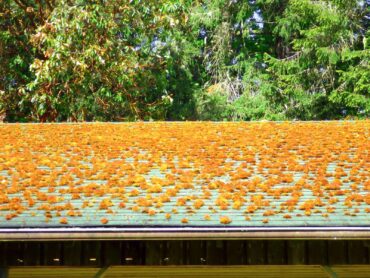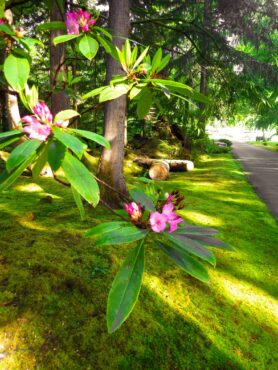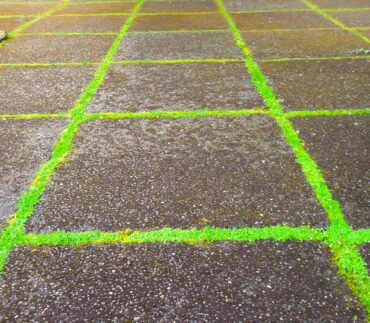
Moss is one of those plants that can be both beautiful and problematic, depending on where it grows. Although that’s potentially true of most plants, few besides moss will grow on a roof, a sidewalk or even a car. The key to why moss grows equally well in gardens and barren rooftops is rooted (pun intended) in moss biology and the way people maintain areas where moss grows, welcome or not.
How Moss Grows
Moss has a reputation for being a lover of moist locations. But perhaps counterintuitively, most moss species are supremely adapted to tolerate dry conditions. Most other plants adapted to drought by mechanisms that are designed to retain water within the plant body. Moss, on the other hand, freely loses and absorbs water as its environment dries and re-wets.

When dry, moss is completely dormant. Once rain or irrigation hits it, moss soaks up the water and begins growing again within minutes. This ability to shake off drought and keep growing after a little watering makes moss more drought-tolerant than even cacti. Pretty impressive for a plant typically associated with rainforests and shady groves.
Even more impressive is that moss also lacks true roots. Yes, roots, the plant structures associated with absorbing water from the soil, are missing from moss. Instead, moss has very small and short root-like threads called “rhizoids” that only function to anchor the plant to the surface it grows upon.

Unlike true roots that anchor their plant, absorb water and can often store food for the plant, the rhizoids’ sole purpose is to keep moss from blowing or washing away.
The combination of extreme drought tolerance and a lack of true roots is what makes moss equally adapted to tree trunks and rocks in nature. It’s also what enables it to grow on a sidewalk or a roof.
Without true roots, mosses that are adapted to rocks and other hard surfaces don’t need deep soil for roots like most other plants. Many moss species do grow on soil, but they also don’t need to send down deep roots.

The plant’s lack of need for soil is why homeowners have to manage moss on their roofs, but generally never have to pull dandelions from the tiles. As far as moss is concerned, there is little difference between a rooftop and a rocky cliff face. Moss will grow where moss wants to grow.
Most people are acquainted with dealing with moss on rooftops. Fewer are familiar with actually trying to grow moss in their landscapes. For most, if moss adorns the garden, it’s because the moss arrived on its own and is now left alone as it adds to the appeal of the scene.
If you both actively cultivate moss in your garden and manage it on your roofs, you may be aware of one of the secrets of moss gardening: manage moss in the garden as you would maintain a roof or sidewalk. Obviously, this does not involve spraying moss killer on garden moss, but otherwise things are similar.
Sidewalks can grow weeds in their cracks and those weeds are removed. Trees drop leaves and branches on roofs and owners remove the debris. Whether it’s a roof, a sidewalk, a driveway or some other hard surface, proper maintenance of those surfaces normally involves keeping them free of weeds, fallen leaves and other debris. This contributes to an environment that encourages moss growth. Weeds, leaves and other debris that fall on moss block sunlight, preventing moss from growing. Removing these things from a roof helps moss grow. Likewise, removing them from a garden helps moss grow in a garden.

When Moss Is Unwanted
Somehow the myth evolved that moss “roots” could damage roofs by lifting up the tiles when growing in between. Lacking true roots, moss, of course, can’t actually do that, but there are other reasons to prevent it from growing on your roof.
As moss grows on the roof, it can begin to disrupt proper water drainage. Water can potentially accumulate under roof tiles for prolonged periods, increasing the possibility that it can reach the wood structure underneath the tiles. This, in turn, increases the likelihood of structural damage from decay, leaks and water damage inside the house.
To make things worse, water accumulating from roof moss can cause further damage during a winter freeze. As water under the tiles freezes and expands, the tiles can shift or break, leading to not only more water penetration but also shortening your roof’s lifespan.
As magical as a mossy roof may sound, the average home’s roof is not designed for moss. It’s far cheaper to pay for periodic moss removal than to repair or replace a roof because of moss damage.
Products for controlling moss readily are available to the homeowner, but it’s probably best to leave moss control to the professionals. Moss killers can be caustic to metals, cause injury to the applicator or others, and concrete or stone.
Dealing with moss on roofs risks injury from falling and the potential for damaging the roof if done improperly. West Sound has experienced companies that can safely remove moss from roofs and other surfaces.
When Moss Is Desired
In a garden setting, moss can be highly desirable. Small amounts on trees or stones add green interest, but you can also use moss in larger volumes as ground covers. As an extreme example, an entire garden could be devoted to moss, as is the case with the Moss Garden at the Bloedel Reserve on Bainbridge Island.

Really anyone can grow moss — even without trying. Probably no one is trying to grow moss on their home roof, but it still grows there. This is good news for those interested in cultivating moss in their garden. It’s so easy that the key ingredient for any prospective moss gardener is just patience.
Moss grows very slowly. Moss “sod” is only sold by mail order and can be very expensive for larger moss gardens. Local moss gardeners’ best bet is to either propagate moss themselves or let Mother Nature do the work.
The different methods of moss propagation are beyond the scope of this article. Those interested are encouraged to acquire the book “The Magical World of Moss Gardening” by Annie Martin (Timber Press, 2015). Fortunately, there is an easy way to have a moss garden without manual propagation, but it requires patience. A lot of patience.
Mother Nature can grow a moss garden easily. Moss has been around for hundreds of millions of years and is well able to propagate itself. All the patient gardener needs to do is create an environment where moss wants to grow. This is the “Field of Dreams” method: “If you build it, he will come.” In this case, “he” is moss.

Preparing Your Garden
As with any planned garden, a little preplanting design is a good idea. Add a wide variety of growing surfaces to encourage moss species diversity. Include as much as possible bare soil, rocks, trees, old logs and stumps, and contours in the geography. Make sure there is a convenient source of water for irrigation.
Include other types of plants in the garden if desired, but be sure to leave plenty of space for moss to grow. A moss garden is a place where the moss is the focus and not just a component.
On the other hand, maybe moss is not the intended focus and merely meant to complement other plants and structures. That is OK, too. Mother Nature will work with what you provide.
Once the garden space is ready, treat it as a roof or a driveway. Remove any weeds. Keep weeds and debris off surfaces intended for moss. Prune encroaching plants. Any moss that begins to grow will have plenty of light and access to water and will not have to compete with weeds. Water occasionally during dry spells to speed up moss growth.
After all this is done, the need for patience kicks in. Without actively propagating moss, it can take several years for it to naturally fill in. But it will fill in eventually — and the result will be a green garden that has that primeval feel that only moss can give.





























